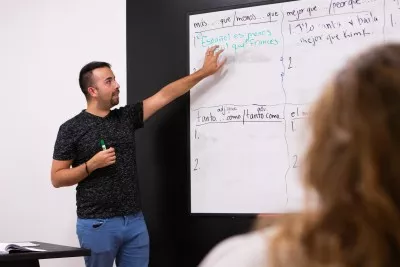
Learn to speak about the past in Spanish with proper grammar and confidence.
You'll master the preterite tense, which will allow you to discuss what happened yesterday, last month, or years ago, and you'll also expand your vocabulary with professions, physical descriptions, and personality traits.
Through ten structured units, you'll practice essential conversational patterns until speaking in the past tense—a skill that separates beginners from real Spanish speakers—becomes natural.
To take this level, you should have scored at least 6 points on our Online Placement Test and/or completed the Beginners Level.
How it works
Course Content
Lesson 1: Ser & estar beyond permanent vs. temporary
When you first start learning Spanish, you may hear that ser is used for permanent attributes and estar for temporary ones. However, that's not entirely accurate. In this class, you'll learn a lot of vocabulary and how to use ser and estar correctly.
By the end of this class, you'll describe people accurately using the right verb choice—a distinction that separates beginners from confident speakers.
Lesson 2: Comparatives, superlatives, and preterite
In this class, you'll learn how to use comparatives and superlatives, as well as the preterite tense (pretérito perfecto), with a focus on the verbs ir (to go) and hacer (to do/make). You'll also learn the months of the year in Spanish.
Lesson 3: The Spanish past tense: ser, estar, tener, and regular verbs
In this class, you'll gain a strong understanding of key Spanish verbs in the preterite tense (pretérito perfecto), including ser (to be), estar (to be), and tener (to have). You'll also learn how to conjugate regular Spanish verbs in the preterite, with a focus on the most commonly used verbs.
Lesson 4: Spanish past tense practice, time expressions, and demonstratives
In this class, you'll practice using the past tense in Spanish, reinforcing your understanding of key time expressions like antes (before), después (after), and durante (during). You’ll also learn how to use Spanish demonstrative adjectives and pronouns.
Lesson 5: Spanish past tense practice and two-verb constructions
In this class, you'll practice the preterite tense and learn how to use two-verb constructions.
Lesson 6: Spanish past tense practice and numbers 101 to 1 million
In this class, you'll practice the preterite tense and learn how to count to a million.
Lesson 7: Spanish past tense practice, impersonal constructions, and present progressive
In this class, you'll practice the Spanish past tense and learn how to use hacer in impersonal constructions. You’ll also explore the four seasons (las cuatro estaciones) and the Spanish present progressive tense. Additionally, you'll master the difference between ir (to go) and irse (to leave).
Lesson 8: Spanish past tense practice, conocer & saber, and common adverbs
In this class, you'll practice the Spanish past tense and learn how to use conocer and saber (both meaning 'to know,' but used in different contexts). You'll also learn how to express something, nothing, somebody, and nobody in Spanish, as well as how to use the adverbs también and tampoco.
Lesson 9: Spanish past tense review
In this class, we'll review the past tense, covering basic irregular verbs, regular verbs ending in -ar, -er, and -ir, along with descriptive vocabulary, two-verb constructions, impersonal constructions, and the present progressive tense. You'll also write a short essay using the past tense, entirely in Spanish!
Lesson 10: Spanish past tense review
In this class, we'll review and practice the Spanish past tense and read and discuss a medium-length text.
